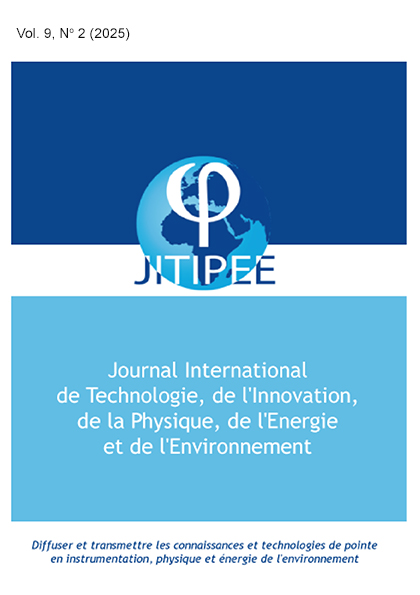Rôles des microorganismes dans le processus de lombricompostage
DOI :
https://doi.org/10.52497/jitipee.v9i2.376Résumé
Le lombricompostage est une forme de valorisation des déchets organiques en fertilisant biologique sous l’action des vers de terre, mais également avec l'activité microbiologique. Cette étude vise à améliorer la qualité du lombricompost avec l’inoculation des bactéries favorisant la croissance des plantes. Pour ce faire, pendant 50 jours la capacité de deux souches (un Rhizobium et une Bactérie Solubilisatrice de Phosphate (BSP)) à survivre et à améliorer le lombricompost a été testé. La qualité microbiologique (densité de microorganismes inoculés) et les propriétés chimiques (teneurs en carbone (C), Azote (N), phosphore (P), potassium (K) et rapport carbone/azote (C/N)) des lombricomposts inoculés ont été évaluées. Les résultats ont montré que le lombricompost inoculé par Rhizobium ont une amélioration significative en nombre de Rhizobium à la fin de l’expérimentation (50ème jour), alors que celui inoculé par la BSP montre un nombre significativement élevé en BSP au 25ème jour. Pour la composition chimique, le lombricompost inoculé par Rhizobium présente une concentration significativement élevée en phosphore (P) et en potassium (K) au 50ème jour de l’expérimentation, tandis que celui qui est inoculé par la BSP présente une forte concentration en phosphore (P) et un rapport C/N élevé au 25ème jour de l’expérimentation. Cette étude a permis de mettre en évidence les potentialités de l’inoculation microbienne à améliorer la qualité du lombricompost.
Références
Tilman, D., Balzer, C., Hill, J., & Befort, B. L. (2011). Global food demand and the sustainable intensification of agriculture. Proceedings of the national academy of sciences, 108(50), 20260-20264.
https://doi.org/10.1073/pnas.1116437108
Moya, B., Parker, A., Sakrabani, R., & Mesa, B. (2019). Evaluating the efficacy of fertilisers derived from human excreta in agriculture and their perception in Antananarivo, Madagascar. Waste and Biomass Valorization, 10, 941-952.
HTTPS://DOI.ORG/10.1007/s12649-017-0113-9
Ranaivoarisoa, H., Ravoninjiva, S., Ramananarivo, S., & Ramananarivo, R. (2016). Vermiculture for Sustainable Organic Agriculture in Madagascar. Horticulturae, 3(1), 2.
HTTPS://DOI.ORG/10.3390/horticulturae3010002
NEPAD-CAADP (2015). The Abuja declaration on fertilizers for an African Green Revolution: status of implementation at regional and national levels.
Elalami, D., Carrere, H., Monlau, F., Abdelouahdi, K., Oukarroum, A., & Barakat, A. (2019). Pretreatment and co-digestion of wastewater sludge for biogas production: Recent research advances and trends. Renewable and Sustainable Energy Reviews, 114, 109287.
HTTPS://DOI.ORG/10.1016/j.rser.2019.109287
Joncoux, S. (2013). Les" produits résiduaires organiques" pour une intensification écologique de l'agriculture : ressources, déchets ou produits ? : sociologie des formats de valorisation agricole, Doctoral dissertation, Université Toulouse le Mirail-Toulouse II.
https://theses.hal.science/tel-00989973/
Gourdon, R. (2010). Impact de nouveaux modes de gestion sur l’accélération de la dégradation de déchets ménagers : approche multiparamétrique et multi-échelle, thèse de doctorat, Université de Provence.
https://cdn.unilim.fr/files/theses-doctorat/2010LIMO4077.pdf
Goret, M. (2019). Etude des interactions entre le climat urbain et le CO2 : modélisation des flux de CO2 et application à l'échelle d'une ville, thèse de doctorat, Université de Toulouse.
https://theses.hal.science/tel-04169779/
Rajiv K, S., Sunita, A., Krunal, C., Vinod, C., & Brijal Kiranbhai, S. (2010). Vermiculture technology: reviving the dreams of Sir Charles Darwin for scientific use of earthworms in sustainable development programs. Technology and Investment, 1(3), 155-172.
HTTPS://DOI.ORG/ 10.4236/ti.2010.13019
Suthar, S., & Singh, S. (2008). Vermicomposting of domestic waste by using two epigeic earthworms (Perionyx excavatus and Perionyx sansibaricus). International Journal of Environmental Science & Technology, 5, 99-106.
HTTPS://DOI.ORG/10.1007/BF03326002
Kuppuraj Rajasekar, K. R., Thilagavathy Daniel, T. D., & Natchimuthu Karmegam, N. K. (2012) Microbial enrichment of vermicompost. International Scholarly Research Notices, 2012(1), 946079.
HTTPS://DOI.ORG/10.5402/2012/946079
Sinha, R. K., Herat, S., Agarwal, S., Asadi, R., & Carretero, E. (2002). Vermiculture and waste management: study of action of earthworms Elsinia foetida, Eudrilus euginae and Perionyx excavatus on biodegradation of some community wastes in India and Australia. Environmentalist, 22, 261-268.
HTTPS://DOI.ORG/10.1023/A:1016583929723
Malusa E., Sas-Paszt L., Ciesielska J. 2012. Technologies for beneficial microorganisms inocula used as biofertilizers. Sci. World J. 12 p
HTTPS://DOI.ORG/10.1100/2012/491206
Arora N. K., Khare E., Naraian R., Maheshwari D. K. 2008. Sawdust as a superior carrier for production of multipurpose bioinoculant using plant growth promoting rhizobial and pseudomonad strains and their impact on productivity of Trifolium repense. Curr. Sci. 95 (1) : pp 90-94.
https://www.jstor.org/stable/24103283
Manantsoa F. F., Baohanta R. H., Rabendalana R. P., Andriambololona N. S., Ratsizafy Irinah, Ramanankierana H. (2023). Optimisation de la composition du substrat pour une meilleure qualité du lombricompost. 40ème anniversaire de la FSTE, Université de Mahajanga. Article soumis pour publication.
Ndegwa, P. M., & Thompson, S. A. (2001). Integrating composting and vermicomposting in the treatment and bioconversion of biosolids. Bioresource technology, 76(2), 107-112.
HTTPS://DOI.ORG/10.1016/S0960-8524(00)00104-8
Jadhav, R. N. (2013). Isolation of rhizobia from soybean cultivated in Latur area and study of its phosphate solubilization activity. Bioscience discovery, 4(1), 100-103.
https://jbsd.in/Volume%204%20No1%20Jan%2013/R%20N%20Jadhav%20100-103.pdf
Tittabutr, P., Teamthisong, K., Buranabanyat, B., Teaumroong, N., & Boonkerd, N. (2012). Gamma irradiation and autoclave sterilization peat and compost as the carrier for rhizobial inoculant production. J. Agric. Sci. 4(12) : pp 59-67.
HTTPS://DOI.ORG/10.5539/jas.v4n12p59
Jordan, D. C. (1982). Transfer of Rhizobium japonicum Buchanan 1980 to Bradyrhizobium gen. nov., a genus of slow-growing, root nodule bacteria from leguminous plants. International Journal of Systematic and Evolutionary Microbiology, 32(1), 136-139.
HTTPS://DOI.ORG/10.1099/00207713-32-1-136
Rao, H. C., Sreenivasa, M. N., Hebsur, N. S., Geetha Shirnalli, G. S., & Babalad, H. B. (2012). Influence of microbial enrichment on microbial population and nutrient status of organic manures. (2012): 545-547.
http://pub.uasd.edu/ojs/index.php/kjas/article/viewFile/2768/2560
Temprano, F., Albareda, M., Camacho, M., Daza, A., Santamaria, C., & Rodríguez-Navarro, N. D. (2002). Survival of several Rhizobium/Bradyrhizobium strains on different inoculant formulations and inoculated seeds. International Microbiology, 5(2), 81-86.
HTTPS://DOI.ORG/10.1007/s10123-002-0067-y
Campello, F. (1983). Tables pour le dénombrement des micro-organismes après culture (milieux solides). Extension à la recherche.
https://archimer.ifremer.fr/doc/00000/4580/
Mouria, B., Ouazzani-Touhami, A., & Douira, A. (2013). Isolement et identification de la mycoflore du compost des déchets urbains solides. Nature & Technology, (9), 13.
https://www.vitaminedz.com/articlesfiche/7258/7258505.pdf
Mylavarapu, R., Sikora, F. J., & Moore, K. P. (2014). Walkley-Black Method. Soil test methods from the Southeastern United States, 158.
http://aesl.ces.uga.edu/sera6/MethodsManualFinalSERA6.pdf
Bray, R. H., & Kurtz, L. T. (1945). Determination of total, organic, and available forms of phosphorus in soils. Soil science, 59(1), 39-46.
HTTPS://DOI.ORG/10.1097/00010694-194501000-00006
Crooke, W. M., & Simpson, W. E. (1971). Determination of ammonium in Kjeldahl digests of crops by an automated procedure. Journal of the Science of Food and Agriculture, 22(1), 9-10.
HTTPS://DOI.ORG/10.1002/jsfa.2740220104
Sanchez, P. A., Palm, C. A., & Buol, S. W. (2003). Fertility capability soil classification: a tool to help assess soil quality in the tropics. Geoderma, 114(3-4), 157-185.
HTTPS://DOI.ORG/10.1016/S0016-7061(03)00040-5
Tounsi S.H., Dhane S.F., Hammami Z., Hamdi K., Chaabouni A., Bettaieb T., Jeddi F.B. 2015. Effet de la nature et de la stérilisation des supports sur la viabilité et l’activité symbiotique de Rhizobium sullae. J. New Sci. 19(9) : pp 766-772.
Kalra, A., Chandra, M., Awasthi, A., Singh, A. K., & Khanuja, S. P. S. (2010). Natural compounds enhancing growth and survival of rhizobial inoculants in vermicompost-based formulations. Biology and Fertility of Soils, 46, 521-524.
HTTPS://DOI.ORG/10.1007/s00374-010-0443-2
Khare, N., Pathak, D. V., Sangwan, S., & Chawla, N. (2014). Effect of microbial enrichment on microbial population and nutritional status of vermicompost. Res. Environ. Life Sci, 7(3), 153-156.
Shahzad, S., Khan, M. Y., Zahir, Z. A., Asghar, H. N., & Chaudhry, U. K. (2017). Comparative effectiveness of different carriers to improve the efficacy of bacterial consortium for enhancing wheat production under salt affected field conditions. Pak. J. Bot, 49(4), 1523-1530.
Kumar, V., & Singh, K. P. (2001). Enriching vermicompost by nitrogen fixing and phosphate solubilizing bacteria. Bioresource Technology, 76(2), 173-175.
HTTPS://DOI.ORG/10.1016/S0960-8524(00)00061-4
Sohaib, M., Zahir, Z. A., Khan, M. Y., Ans, M., Asghar, H. N., Yasin, S., & Al-Barakah, F. N. (2020). Comparative evaluation of different carrier-based multi-strain bacterial formulations to mitigate the salt stress in wheat. Saudi Journal of Biological Sciences, 27(3), 777-787.
HTTPS://DOI.ORG/10.1016/j.sjbs.2019.12.034
Lee, H., & Lee, D. G. (2019). Programmed cell death in bacterial community: Mechanisms of action, causes and consequences. Journal of Microbiology and Biotechnology, 29(7), 1014-1021.
HTTPS://DOI.ORG/10.4014/jmb.1904.04017
Rodriguez, H., Gonzalez, T., Goire, I., & Bashan, Y. (2004). Gluconic acid production and phosphate solubilization by the plant growth-promoting bacterium Azospirillum spp. Naturwissenschaften, 91, 552-555.
HTTPS://DOI.ORG/10.1007/s00114-004-0566-0
Arancon, N. Q., Edwards, C. A., & Bierman, P. (2006). Influences of vermicomposts on field strawberries: Part 2. Effects on soil microbiological and chemical properties. Bioresource technology, 97(6), 831-840.
HTTPS://DOI.ORG/10.1016/j.biortech.2005.04.016
Arancon, N. Q., Edwards, C. A., Bierman, P., Welch, C., & Metzger, J. D. (2004). Influences of vermicomposts on field strawberries: 1. Effects on growth and yields. Bioresource technology, 93(2), 145-153.
HTTPS://DOI.ORG/10.1016/j.biortech.2003.10.014



